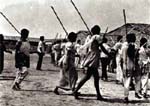 Visual documentation of an extraordinary time and of the people who fought to give birth to a new nation is on display by Abdul Hamid Raihan’s ongoing solo exhibition at Dhaka Art Centre.
Visual documentation of an extraordinary time and of the people who fought to give birth to a new nation is on display by Abdul Hamid Raihan’s ongoing solo exhibition at Dhaka Art Centre.
The freelance photographer from Kushtia district displays 40 historic photographs taken by him during the war of independence in 1971.
Raihan’s stills narrate the stories of vigour, heroism, commitment, sacrifices of the freedom fighters and common people to achieve independence from the Pakistani occupying forces in the war.
His photographs present visual diary of the historic moments of the war from the beginning to the triumphs of the fighters after the surrender of the Pakistani forces and their local collaborators in southwest region.
The displayed photographs not only capture moments of mass uprising, processions, public meetings addressed by important political leaders, refugee camps, guerrilla trainings, destructed bridges, roads and vehicles and others; but like a skilled documentarian Raihan tags dates and locations of the very moment.
In black and white, the photographs at a glance present the versatile aspects of the happening period.
Photographs of the training moments of the freedom fighters give a patriotic stimulation to the viewers. While the spirited mob at public meetings and processions encourage the new generation for offering greater sacrifice for the motherland.
One of his photographs depicts damaged Harding Bridge after air strike by the Indian Air Force on 13 December 1971. As the Pakistani Army was on retreat towards Jessore [their last stronghold in the southwest region] the Harding’s bridge was strategically very important for the joint forces to destroy it.
Born in 1932, Abdul Hamid Raihan started taking photographs when he was only 14. When the war broke up, Raihan with his family took shelter in a refugee camp at Karimpur in India.
Subsequently, he joined the liberation war with his camera. Till September 14, 1971, he was the assistant in-charge of Karimpur recruitment camp which was known as a youth camp, or the feeder camp.
He then joined the volunteer service core of the-then Mujibnagar government as a photographer. He was assigned to visual documentation of the freedom fighters and to record the devastations caused by the Pakistani soldiers, and their local collaborators.
The nine-day exhibition titled ‘Raihan’s 71’ is curated by his son Abdul Halim Chanchal, who is also a visual artist.
The exhibition will remain open from 3pm to 8pm everyday till September 30.
-With New Age input




















